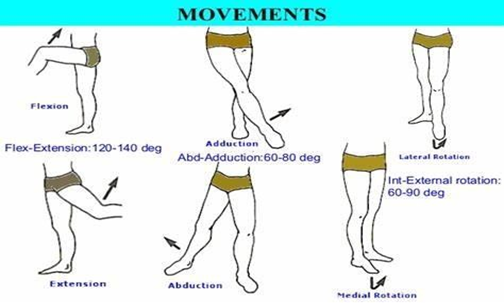The nurse is instructing nurse externs at an extended care facility. What is the expected range of motion of the hip? (SELECT ALL THAT APPLY)
external rotation
extension
adduction
supination
flexion
Correct Answer : A,B,C,E

A. External rotation of the hip involves rotating the thigh outward away from the midline of the body. This movement occurs in the hip joint. External rotation is a component of hip range of motion.
B. Extension of the hip involves moving the thigh backward, straightening the leg from a flexed position. This movement also occurs in the hip joint. Extension is part of the hip's range of motion.
C. Adduction of the hip involves moving the thigh toward or across the midline of the body. It brings the leg closer to the midline. Adduction is another movement that is part of the hip's range of motion.
E. Flexion of the hip involves bringing the thigh toward the abdomen or bending the leg. It is a movement where the angle between the thigh and the abdomen decreases. Flexion is a fundamental movement of the hip joint.
D. Supination is a movement primarily associated with the forearm and hand, involving turning the palm upward or facing forward. It is not a movement of the hip joint. Supination is not correct in the context of hip range of motion.
Nursing Test Bank
Naxlex Comprehensive Predictor Exams
Related Questions
Correct Answer is B
Explanation
B. Activating a code blue or the facility's emergency response system will bring immediate assistance and resources to the client's bedside. This is crucial to initiate prompt resuscitative measures if indicated and to involve additional healthcare providers in the management of the emergency.
A. While it might be appropriate in some situations to provide privacy or support to the partner, in this urgent scenario where the client is unresponsive and not breathing, the priority should be immediate assessment and intervention for the client's condition.
C. While notifying the physician is important, especially to inform them of the client's condition and potentially discuss the DNR status, it is not the most immediate action in this urgent situation where the client is unresponsive and not breathing. Direct intervention and assessment are needed first.
D. Asking the partner to make a DNR decision immediately is not appropriate as the first action in this scenario. It is crucial to focus first on the client's immediate needs for assessment and potentially resuscitative measures if indicated. The discussion about the DNR order should occur in a timely manner but is secondary to addressing the client's current medical emergency.
Correct Answer is A
Explanation
A. Isometric exercises typically involve pushing or pulling against a stationary object or surface. This action creates muscle tension without joint movement.
B. Using a trapeze involves lifting the body and is more related to mobility assistance rather than isometric exercise. It typically involves movement and is not considered an isometric exercise.
C. Brisk walking is a cardiovascular exercise that involves movement and does not focus on muscle contraction without movement. It improves cardiovascular fitness and endurance rather than strength through isometric contraction.
D. Active range of motion exercises involve moving joints through their full range of motion using muscle strength. This is different from isometric exercises, which involve static muscle contractions without joint movement.
Whether you are a student looking to ace your exams or a practicing nurse seeking to enhance your expertise , our nursing education contents will empower you with the confidence and competence to make a difference in the lives of patients and become a respected leader in the healthcare field.
Visit Naxlex, invest in your future and unlock endless possibilities with our unparalleled nursing education contents today
Report Wrong Answer on the Current Question
Do you disagree with the answer? If yes, what is your expected answer? Explain.
Kindly be descriptive with the issue you are facing.
